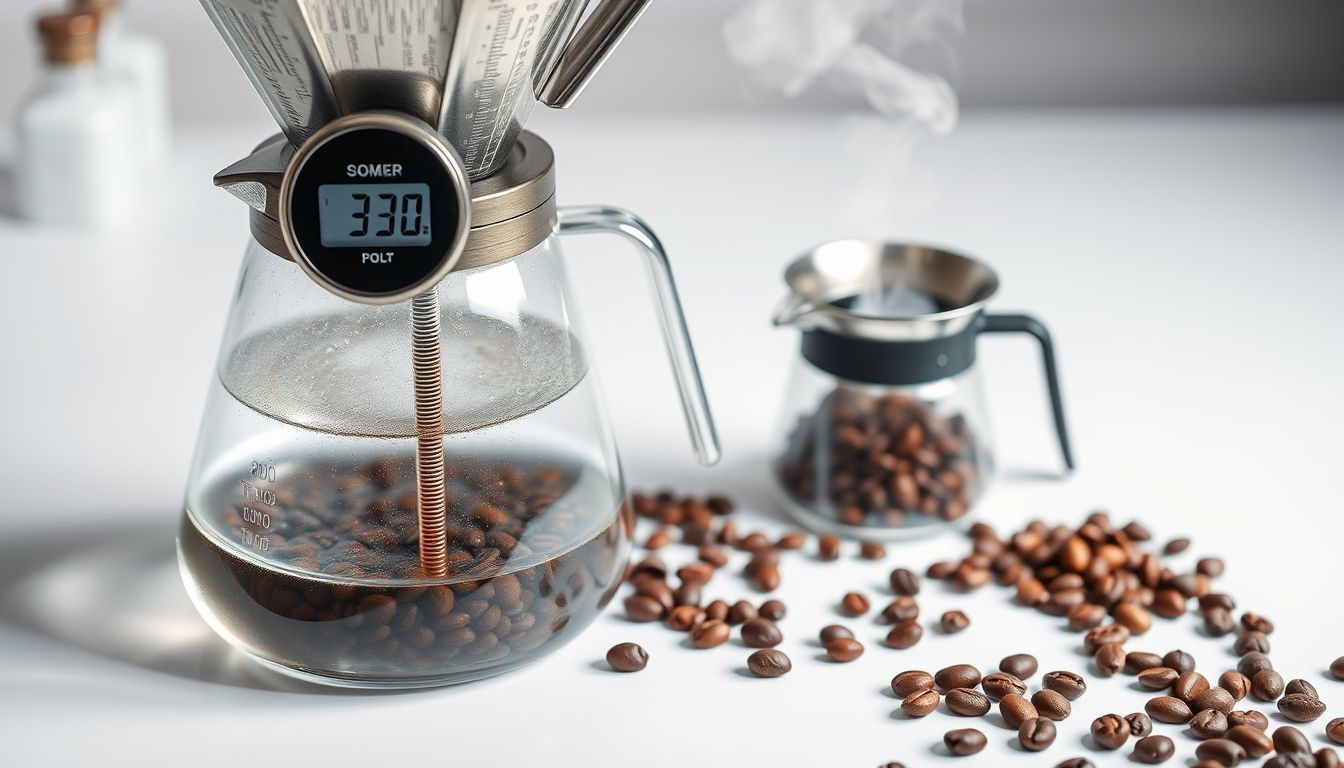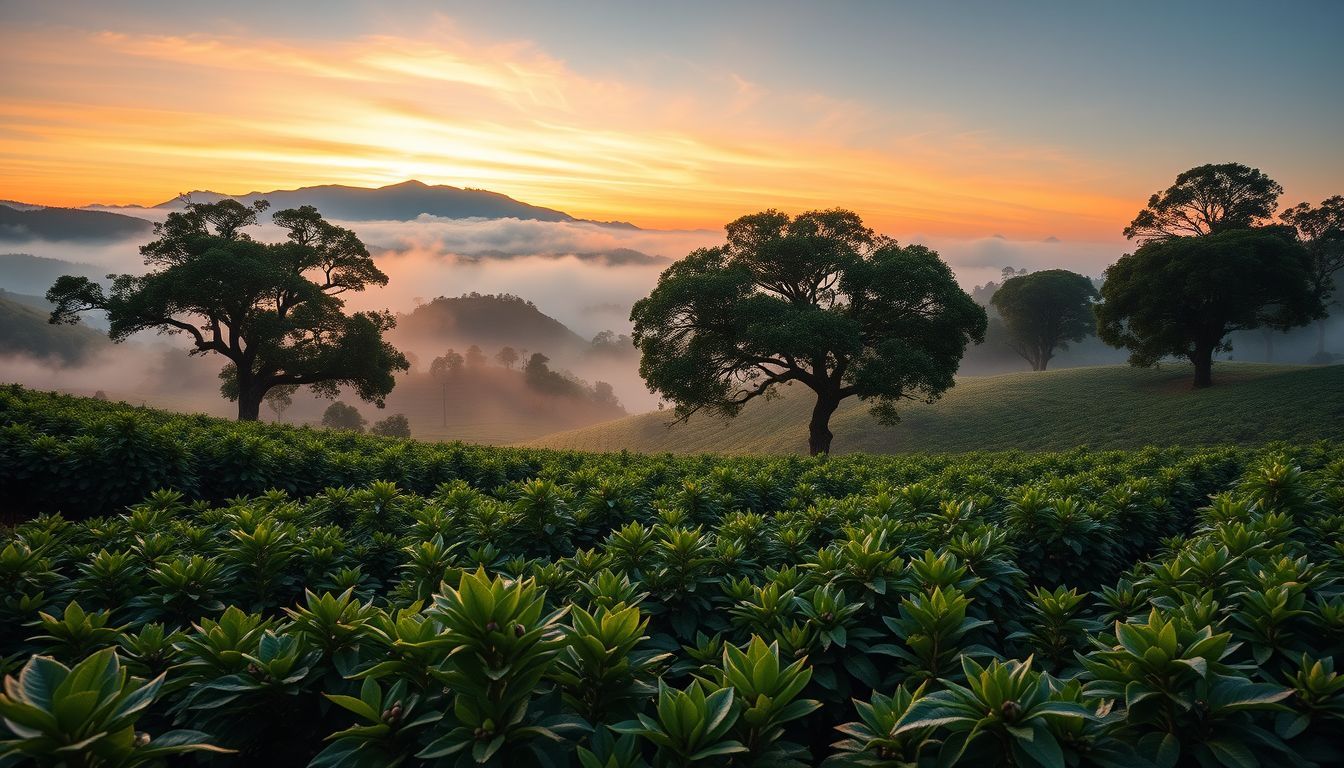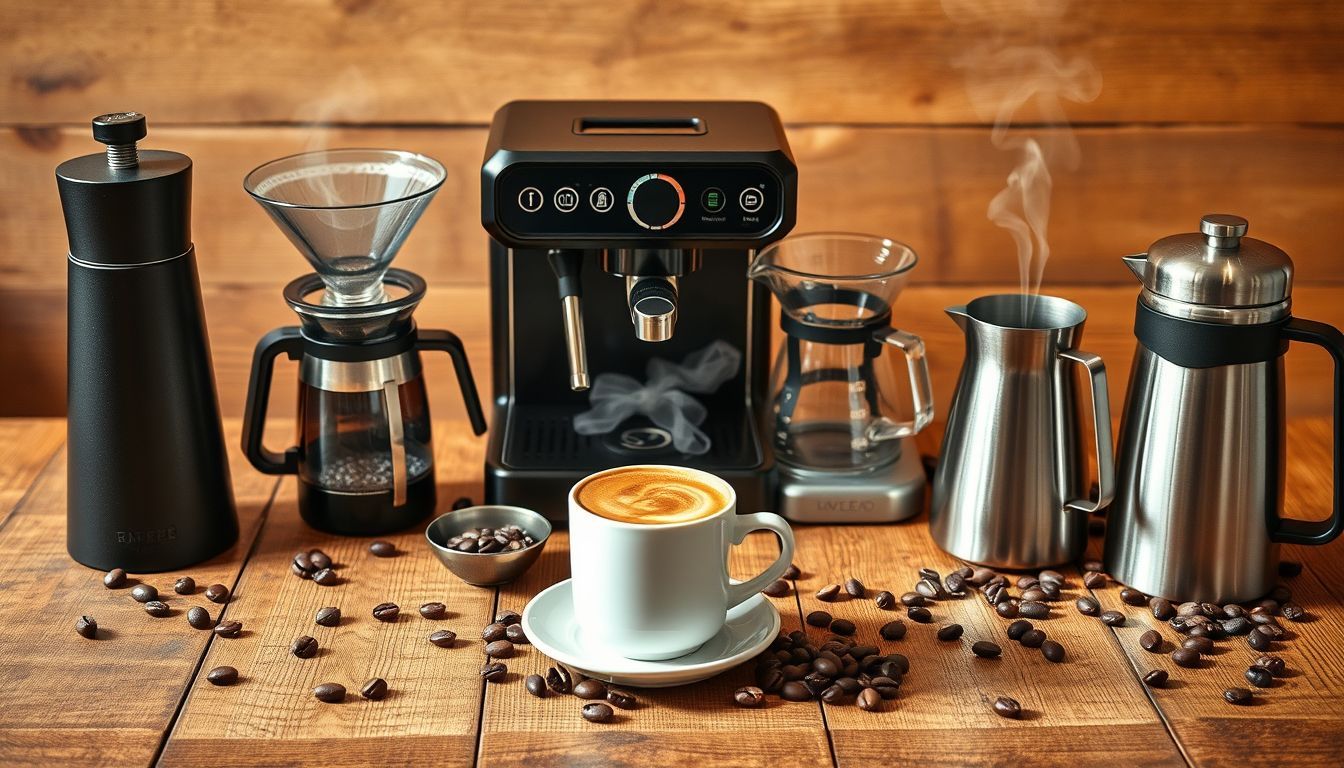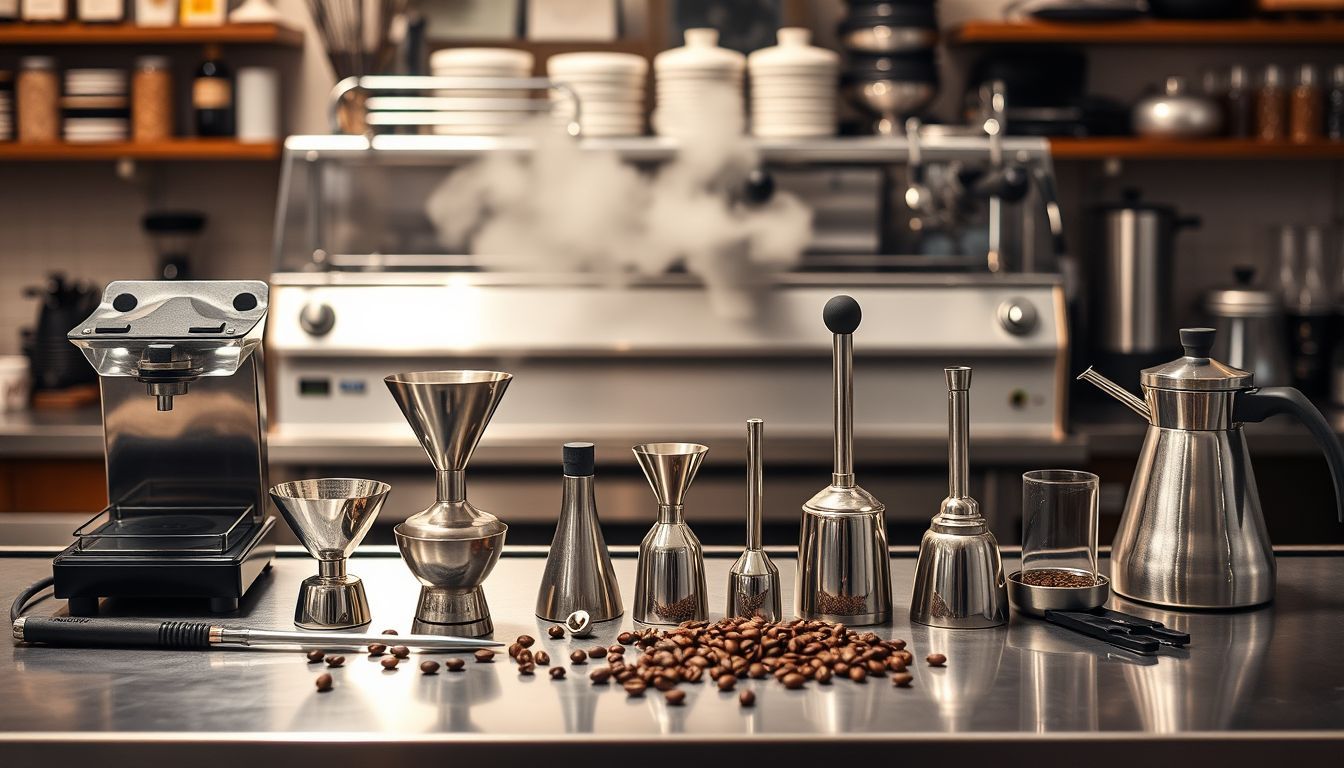The Science Behind Optimal Coffee Extraction Temperatures and How to Perfect Yours
Discover the molecular science behind coffee extraction temperatures and master the precise thermal control that separates exceptional coffee from mediocre brews.

Amazon Affiliate Disclosure
This post contains affiliate links. If you purchase through these links, we may earn a small commission at no additional cost to you.
The Science Behind Optimal Coffee Extraction Temperatures and How to Perfect Yours
Temperature is the invisible conductor orchestrating every coffee extraction, yet it remains one of the most misunderstood variables in brewing. After years of analyzing extraction dynamics and witnessing countless home brewers struggle with inconsistent results, I've become convinced that temperature mastery is the single most transformative skill a coffee enthusiast can develop.
Most coffee drinkers accept whatever temperature their machine delivers, never realizing they're leaving flavor on the table—or worse, extracting compounds that actively diminish their coffee's potential. Today, we'll dissect the molecular science behind extraction temperatures and provide you with the analytical framework to achieve thermal precision in every brew.
This isn't about following arbitrary rules. It's about understanding the fundamental chemistry that governs how water temperature affects solubility, extraction rates, and ultimately, the flavor compounds that reach your cup.
The Molecular Foundation of Temperature-Driven Extraction
Understanding Solubility Dynamics
Coffee extraction is fundamentally a solubility problem. Ground coffee contains over 1,000 chemical compounds, but we don't want to extract them all. Temperature acts as the primary control mechanism, determining which compounds dissolve and at what rate.
At the molecular level, higher temperatures increase kinetic energy, causing water molecules to move faster and interact more aggressively with coffee solids. This increased molecular activity accelerates the dissolution of both desirable and undesirable compounds—the key is finding the temperature sweet spot that maximizes the good while minimizing the bad.
The Extraction Hierarchy
Coffee compounds extract in a predictable sequence based on their molecular structure and solubility characteristics:
1. Acids and salts (185-195°F): Bright, fruity notes that provide coffee's characteristic acidity
2. Sugars and aromatics (195-205°F): Sweetness, body, and complex flavor compounds
3. Bitter compounds and tannins (205°F+): Astringent, harsh flavors that can overwhelm delicate notes
This hierarchy explains why temperature precision matters so dramatically. A few degrees can mean the difference between balanced complexity and bitter disappointment.
The Optimal Temperature Range: 195-205°F Deconstructed
Why This Range Exists
The universally accepted 195-205°F (90-96°C) range isn't arbitrary—it's based on decades of extraction research and sensory analysis. This temperature window maximizes the extraction of desirable compounds while minimizing the dissolution of bitter, astringent elements.
At 195°F: You achieve sufficient energy to extract acids, sugars, and primary aromatics without aggressive tannin extraction. This temperature works exceptionally well for light roasts and delicate single origins.
At 205°F: You reach the upper threshold where extraction efficiency peaks for most coffee without crossing into harsh territory. This temperature suits medium to dark roasts that can handle more aggressive extraction.
The Roast Level Connection
Roast level fundamentally alters coffee's cellular structure, directly impacting optimal extraction temperature:
Light Roasts (195-200°F): Dense cellular structure requires sufficient heat for penetration, but delicate flavor compounds demand restraint. Higher temperatures can overwhelm subtle fruit and floral notes.
Medium Roasts (200-205°F): Balanced cellular breakdown allows for efficient extraction across the full temperature range. This versatility makes medium roasts forgiving for temperature experimentation.
Dark Roasts (190-200°F): Extensively broken-down cellular structure extracts readily, while lower temperatures prevent over-extraction of bitter compounds created during extended roasting.
Brewing Method Temperature Optimization
Pour-Over Precision
Pour-over methods offer the greatest temperature control, making them ideal for exploring extraction nuances.
Optimal Range: 195-205°F
Starting Point: 200°F for medium roasts
Adjustment Strategy: Decrease temperature if coffee tastes bitter or harsh; increase if it tastes weak or sour
Pro Technique: Start your pour at 205°F and allow natural cooling throughout the brew. This creates a temperature gradient that extracts different compounds at different phases.
Espresso Temperature Dynamics
Espresso's pressure-assisted extraction changes temperature requirements significantly.
Optimal Range: 190-196°F
Why Lower: Pressure increases extraction efficiency, requiring lower temperatures to prevent over-extraction
Machine Considerations: Account for temperature loss through group head and portafilter thermal mass
French Press Thermal Management
Immersion brewing requires different temperature considerations due to extended contact time.
Optimal Range: 195-200°F
Why Conservative: Four-minute contact time means aggressive extraction even at moderate temperatures
Heat Retention: Preheat your press to minimize temperature drop during brewing
Cold Brew: The Temperature Exception
Cold brew operates on entirely different extraction principles, using time instead of temperature to achieve extraction.
Temperature: Room temperature (68-72°F)
Extraction Time: 12-24 hours
Result: Low acidity, high sweetness, minimal bitterness due to selective compound extraction
Measuring and Controlling Temperature
Essential Tools for Temperature Mastery
Instant-Read Thermometer: Your primary weapon for temperature verification. Look for models with 1-2 second response times and ±1°F accuracy.
Variable Temperature Kettle: Electric kettles with precise temperature control eliminate guesswork and provide consistency.
Thermal Carafe: Maintains temperature during extended brewing sessions without continued heating that can degrade flavor.
Temperature Measurement Techniques
Water Temperature: Measure at the point of contact with coffee, not in the kettle. Temperature drops 5-10°F during pouring and contact with brewing equipment.
Ambient Considerations: Room temperature affects heat retention. Cold environments require higher starting temperatures to maintain optimal extraction temperature.
Equipment Preheating: Always preheat brewing equipment. Cold metal or ceramic can drop water temperature by 10-15°F instantly.
Advanced Temperature Techniques
Temperature Profiling
Advanced brewers use temperature changes throughout extraction to target specific flavor compounds.
Bloom Temperature: Start 5-10°F higher to ensure proper degassing and initial extraction
Main Pour: Reduce to target temperature for balanced extraction
Final Pour: Slightly lower temperature to avoid over-extraction in final phases
Roast-Specific Temperature Protocols
Light Roast Protocol:
- Start: 200°F
- Bloom: 30 seconds
- Main extraction: 198°F
- Total time: 3-4 minutes
Medium Roast Protocol:
- Start: 202°F
- Bloom: 30 seconds
- Main extraction: 200°F
- Total time: 4-5 minutes
Dark Roast Protocol:
- Start: 195°F
- Bloom: 45 seconds
- Main extraction: 193°F
- Total time: 4-6 minutes
Troubleshooting Temperature-Related Issues
Diagnosing Temperature Problems
Sour, Weak Coffee: Usually indicates under-extraction due to insufficient temperature
- Solution: Increase temperature by 3-5°F
- Alternative: Extend contact time or use finer grind
Bitter, Harsh Coffee: Typically signals over-extraction from excessive temperature
- Solution: Decrease temperature by 3-5°F
- Alternative: Reduce contact time or use coarser grind
Inconsistent Results: Often caused by temperature fluctuations
- Solution: Invest in better temperature control equipment
- Practice: Develop consistent preheating and measurement routines
Environmental Factors
Altitude Effects: Higher altitudes have lower boiling points, affecting optimal extraction temperatures. Reduce target temperature by 1°F per 1,000 feet of elevation.
Humidity Impact: High humidity can affect heat transfer and retention. Monitor and adjust accordingly.
Seasonal Variations: Winter brewing often requires higher starting temperatures due to cold equipment and ambient conditions.
The Economics of Temperature Control
Equipment Investment Priorities
1. Instant-read thermometer ($15-30): Immediate impact, essential for learning
2. Variable temperature kettle ($50-150): Dramatic consistency improvement
3. Thermal brewing equipment ($100-300): Professional-level control
Cost-Benefit Analysis
Temperature control equipment pays for itself through:
- Reduced waste: Fewer ruined batches due to temperature errors
- Bean optimization: Extract maximum value from premium coffee purchases
- Consistency: Reliable results reduce frustration and experimentation costs
Building Your Temperature Mastery Protocol
Week 1: Baseline Establishment
- Measure your current brewing temperatures
- Document flavor results at different temperatures
- Identify your equipment's temperature characteristics
Week 2: Systematic Experimentation
- Test 3°F increments within the optimal range
- Keep detailed tasting notes
- Identify your personal preference patterns
Week 3: Method-Specific Optimization
- Apply learnings to different brewing methods
- Adjust for different roast levels
- Develop your personal temperature protocols
Week 4: Consistency Development
- Focus on repeatable processes
- Refine measurement techniques
- Build muscle memory for optimal temperatures
Conclusion: Temperature as Your Competitive Advantage
Temperature control separates casual coffee drinkers from serious practitioners. It's the difference between accepting whatever your equipment delivers and actively orchestrating the extraction process to achieve your vision of perfect coffee.
The science is clear: temperature directly controls which compounds extract from your coffee and at what rate. Master this variable, and you gain unprecedented control over your coffee's flavor profile. Ignore it, and you're essentially brewing blind, hoping for good results rather than engineering them.
Start with the fundamentals: invest in a quality thermometer, establish baseline measurements, and begin systematic experimentation. Temperature mastery isn't achieved overnight, but every degree of precision you gain translates directly into better coffee.
Remember, the optimal temperature isn't a fixed number—it's a dynamic variable that changes based on your coffee, your method, your equipment, and your taste preferences. The goal isn't to follow someone else's temperature recommendations blindly, but to understand the underlying principles well enough to make informed decisions for every brewing situation.
Your coffee deserves this level of attention. More importantly, you deserve the exceptional results that temperature mastery delivers. The science is on your side—now it's time to put it to work.

Marcus Thorne
As a journalist, I learned that the truth is often buried under layers of misinformation and time. As a novelist, I get to do the digging. Whether it's a forgotten event from the Cold War or a present-day conspiracy, I build my stories on a foundation of fact, inviting you to question what you think you know.


